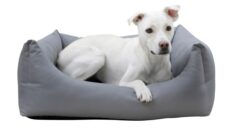
As the crisp air of winter sets in, painting our surroundings with frosty hues, it’s a time to cozy up and enjoy the warmth of home. This change of season, however, brings unique challenges for pet owners. Our furry friends, from the spirited dogs to the cuddly cats, experience winter differently. The purpose of this blog is to delve into the necessities of winter pet care, ensuring our pets are safe, happy, and healthy as temperatures drop.
Pets, much like humans, have varied responses to cold weather. Dogs and cats, for instance, have different fur densities and breed characteristics that influence their tolerance to cold. Some breeds are naturally equipped for chilly climates, while others may need additional care and warmth. The distinction between indoor and outdoor pets is also crucial in winter months. Outdoor pets might require a gradual transition to indoor living or extra measures to ensure their comfort outside. Recognizing signs of cold stress, such as shivering or lethargy, is vital in maintaining their well-being.
Winter calls for adjustments in our pet care routines. This might mean modifying exercise schedules, diet plans, and even their sleeping arrangements to suit the colder weather. Regular health checks become even more significant, as winter can bring about specific health issues. Creating a warm and inviting space for our pets is not just about physical comfort; it also encompasses their emotional well-being. During the less active winter months, keeping them mentally stimulated is just as important.
Deciphering Your Pet’s Cold Tolerance: A Guide to Keeping Them Safe and Comfortable
Imagine a chilly winter morning: you’re bundled up in layers, but what about your furry companion? As temperatures drop, pet owners often find themselves pondering over the comfort and safety of their pets in the cold. This blog delves into the crucial aspect of understanding your pet’s individual tolerance to cold weather. We aim to guide pet owners in recognizing and adequately responding to their pets’ needs during the colder months.
Pets come in all shapes and sizes, and their breed and size significantly influence how they cope with the cold. For instance, breeds with thick fur like Huskies thrive in cold weather, while those with thinner coats may struggle. Similarly, the size of a pet plays a role; smaller breeds tend to get cold more quickly than larger breeds. This section will explore how different breeds and sizes adapt to colder climates and what owners can do to facilitate this acclimatization.
Recognizing the signs of cold stress in pets is crucial. Physical symptoms like shivering, hunching, or lethargy, along with behavioral changes such as reluctance to go outside or altered sleeping patterns, are telltale signs. This section will provide insights into these signs and offer advice on immediate actions to take if a pet shows symptoms of cold stress.
The distinction between indoor and outdoor pets is significant in winter. For indoor pets, tips on maintaining a warm and comfortable environment will be discussed, including bedding and room temperature. In contrast, for outdoor pets, guidance on appropriate shelter, access to unfrozen water, and knowing when to bring them indoors will be provided. Additionally, advice on transitioning pets between indoor and outdoor settings in cold weather will be shared.
Creating a Cozy Refuge for Your Pets: Indoor and Outdoor Warmth Strategies
As pet owners, we understand that our furry friends rely on us for comfort and safety, regardless of the weather outside. With the changing seasons, especially as we approach the colder months, ensuring a cozy and safe environment for our pets becomes paramount.
When it comes to keeping our pets warm indoors, understanding the ideal room temperature and safe heating practices is crucial. We’ll discuss how to create pet-friendly zones in your home, areas specifically designed for your pet’s warmth and comfort. Additionally, the importance of monitoring indoor conditions like humidity will be highlighted to prevent discomfort from overly dry air.
For pets who spend time outdoors, having a safe and warm shelter is critical. This part of the blog will provide guidance on choosing or building the right outdoor shelter. We’ll focus on aspects like insulation, waterproofing, and protection from the wind. Ensuring access to essentials like unfrozen water and dog food in protected areas is also vital. Regular checks of outdoor shelters for their integrity and safety will be emphasized.
Choosing the right dog bedding material is essential for your pet’s warmth and comfort. We’ll explore the benefits of various bedding materials, such as fleece, straw, or specialized pet bed fillings. The discussion will also cover the optimal placement for pet beds and the importance of their regular cleaning and maintenance. Additionally, alternatives for added warmth, like pet-safe heating pads or blankets, will be suggested.

Navigating Nutritional Needs and Health Care for Pets in Winter
As winter wraps its chilly arms around us, pet owners may wonder: how does this cold affect my furry friend? The shift in seasons brings with it a need to reassess and adapt our pets’ care, particularly in terms of nutrition and health.
During winter, pets may require a higher caloric intake to maintain their body heat and energy levels. This section will discuss how to safely adjust your pet’s diet to meet these increased needs. Alongside this, the importance of hydration cannot be overstressed, even in colder weather. We’ll provide practical tips for ensuring that pets remain well-hydrated throughout the winter months. Additionally, the need for a balanced diet that addresses specific winter nutritional requirements will be highlighted.
Winter can bring about specific health concerns for pets, such as dry skin and arthritis. This part of the post will offer advice on managing dry skin through dietary supplements and grooming techniques. For pets suffering from joint pain or arthritis, common signs and methods to alleviate discomfort will be discussed. We will also touch upon preventative measures to avoid common winter ailments, such as increased grooming and the use of pet-friendly moisturizers.
Regular veterinary check-ups gain an added significance in winter. These visits are crucial for the early detection and management of any health issues that may arise during the colder months. The post will also remind readers about the necessary vaccinations and preventative care routines that are particularly important as the weather changes. Additionally, the value of maintaining open communication with veterinarians will be emphasized, ensuring that each pet receives personalized care tailored to their specific needs.
10 quick tips for keeping your pets cosy and safe this winter!
Warm Shelter: Ensure your pets have a warm, dry, and draft-free shelter, especially if they spend a lot of time outdoors. Indoor living is preferable during extreme cold.
Bedding: Provide thick, warm bedding away from cold floors or drafts. Elevated beds can also help keep them warm.
Outdoor Time: Limit the time your pets spend outside during extremely cold weather. Even fur-coated animals can be vulnerable to hypothermia and frostbite.
Paw Protection: Use pet-safe ice melts on your driveways and walkways. Check and clean your pet’s paws after outdoor walks to remove ice, salt, and chemicals.
Winter Clothing: Consider sweaters or coats for short-haired breeds, senior pets, or those with medical conditions.
Hydration: Ensure your pet has access to fresh, unfrozen water. Cold weather can be dehydrating.
Nutrition: Your pet may need more calories in the winter to stay warm. Consult your vet about your pet’s dietary needs during colder months.
Avoid Antifreeze: Keep antifreeze, which can be lethal to pets, out of reach. Use pet-friendly products.
Exercise Indoors: Find ways to keep your pet active indoors if the weather is too harsh for outdoor activities.
Regular Check-ups: Winter can be tough on pets’ health, especially those with arthritis or other medical conditions. Maintain regular vet check-ups.
Ensuring Safe and Enjoyable Winter Activities for Your Pets
As the winter season rolls in, many pet owners find themselves pondering: how can I keep my pet active and safe in this chilly weather? While the colder months pose unique challenges, they also offer opportunities for fun and engaging activities with our pets. This blog is dedicated to providing pet owners with innovative tips and ideas for ensuring their pets stay active, happy, and safe during winter.
Exercise and play are essential for a pet’s health, even more so in winter. We will suggest a variety of winter-friendly outdoor activities tailored to different weather conditions and pet types. An important aspect of outdoor play is dressing pets appropriately for the cold, so we’ll discuss the significance of protective gear like coats and paw protectors. Additionally, for those days when the weather outside is too severe, we’ll offer creative ideas for keeping pets active indoors.
Winter brings with it certain hazards that pet owners need to be aware of. This part of the blog will highlight potential dangers such as antifreeze spills, icy conditions, and snow. We will provide practical prevention strategies to keep pets safe and tips on how to respond to accidents. Furthermore, the importance of emergency preparedness, including maintaining a pet first-aid kit, will be emphasized.
Keeping pets mentally stimulated indoors is just as important as physical exercise. We’ll suggest a range of interactive toys and games that can keep pets entertained inside. For the DIY enthusiasts, there will be creative ideas for constructing stimulating environments at home. Additionally, the benefits of indoor training sessions and bonding activities will be discussed, emphasizing their role in enhancing your pet’s mental well-being during the colder months.
Grooming and Apparel for Pets in Winter: Keeping Your Furry Friends Warm and Protected
As winter envelops us in its chilly embrace, our pets face unique challenges. Their skin and coat, crucial for warmth and protection, require special attention during this season. This blog post aims to enlighten pet owners about the importance of winter grooming and choosing the right apparel for their furry companions.
The colder months necessitate a change in grooming routines to maintain the health of your pet’s skin and coat. We will explore how to adapt these routines, including the right brushing techniques and frequency. Bathing practices and the use of pet-friendly moisturizers play a crucial role in preventing dry skin. Additionally, managing wet fur, a common issue in winter due to snow and rain, will also be addressed.
Selecting the appropriate apparel for your pet is not just a fashion statement—it’s a necessity for their warmth and protection in winter. This part of the post will discuss how to choose suitable clothing based on your pet’s breed and size. We will also offer guidance on selecting the right materials and designs that provide warmth while ensuring ease of movement. The safety and comfort of the pet while wearing these clothes will be a priority.
Paw care is an essential aspect of winter pet care. We will share effective methods for protecting your pet’s paws from harsh winter elements like salt, ice, and snow, which may include using booties or protective balms. Regular checks and cleaning of paws to prevent irritation or injury will be emphasized. Additionally, advice on safely removing snow and ice accumulation in fur and between toes will be provided.
Conclusion
As the winter season unfolds, it brings with it a unique opportunity to deepen the bonds we share with our pets. The cold months provide a backdrop for creating special moments and memories with our furry companions, highlighting the importance of pet care during this time. This blog post aims to not only revisit essential winter pet care tips but also to foster a sense of community among pet lovers.
The post begins by summarizing the key insights from previous discussions, covering vital aspects such as grooming, diet, exercise, and health care during the colder months. Each of these plays a crucial role in ensuring a pet’s well-being as temperatures drop.
Central to this blog post is the encouragement of reader engagement. We invite our readers to share their own experiences and stories about caring for their pets during winter. This section is a call to action, aiming to build a supportive and informative community of pet owners. By sharing personal insights and tips, pet lovers can learn from and support each other, enriching the collective knowledge of the community.
In the closing remarks, the post reflects on the joys and responsibilities of pet parenting during winter. It emphasizes the continuous commitment required in pet care, while also acknowledging the immense joy and fulfillment that comes from this special relationship. The post concludes with a note on how the winter season, with its unique challenges and opportunities, can be an especially rewarding time for strengthening the bond with our pets.
In summary, this blog post serves as a comprehensive guide and a platform for shared experiences, aimed at enhancing the winter experience for pets and their owners alike. By focusing on essential care tips and encouraging community engagement, it seeks to enrich the lives of pets and their owners, making winter a joyous and comfortable season for all.

























